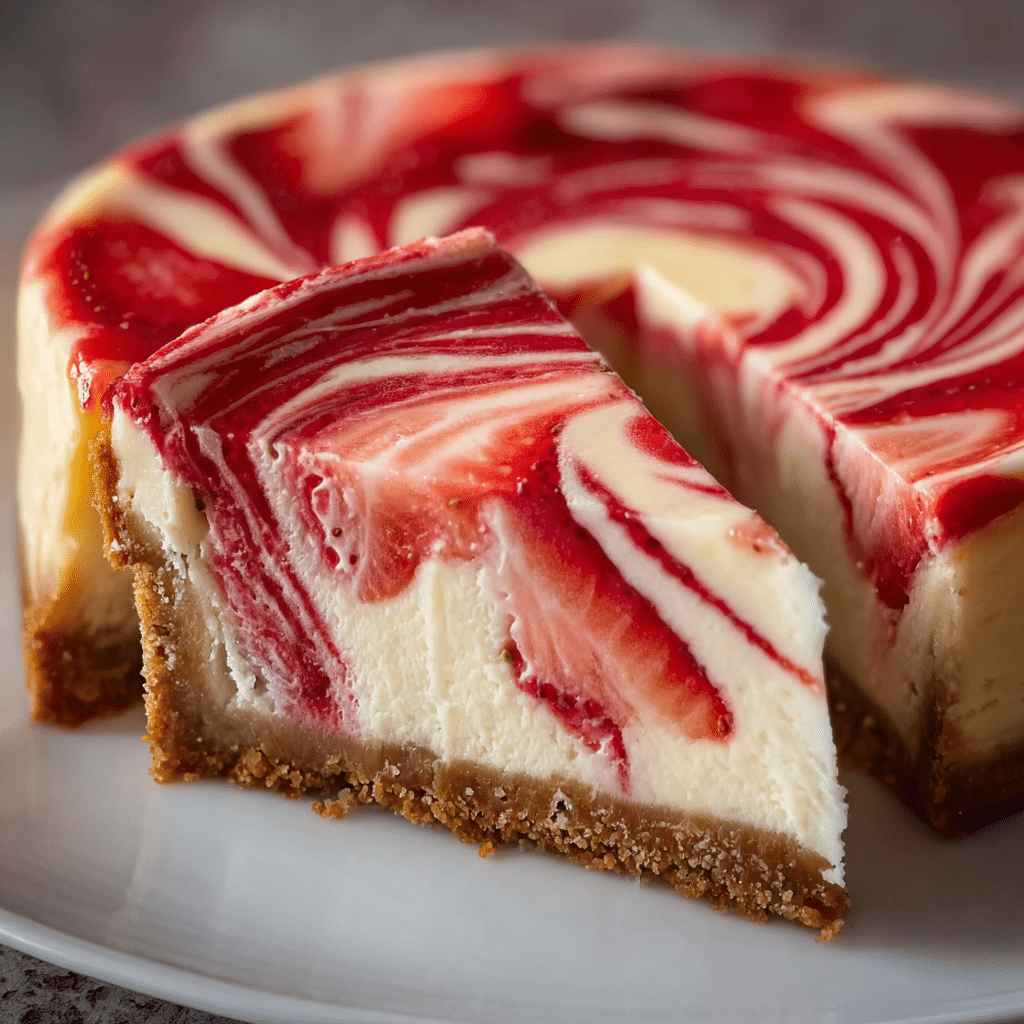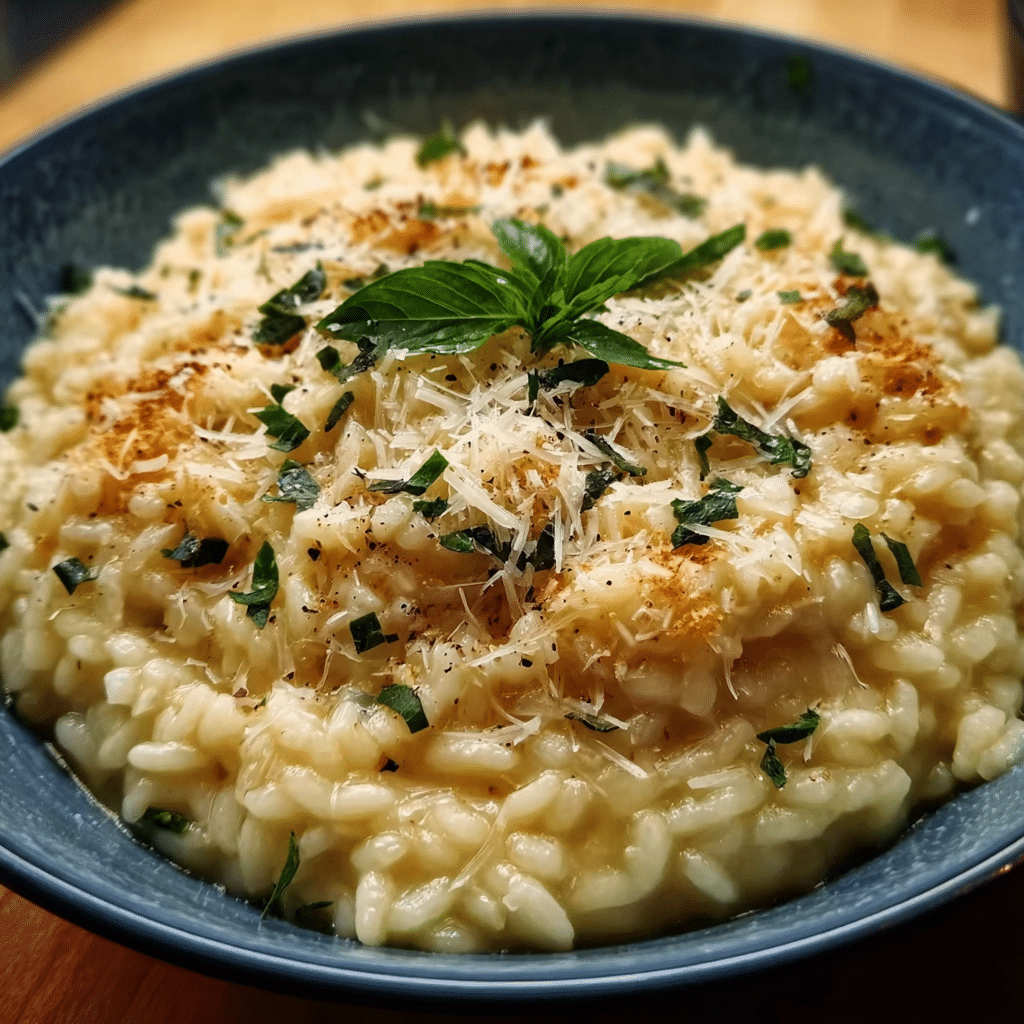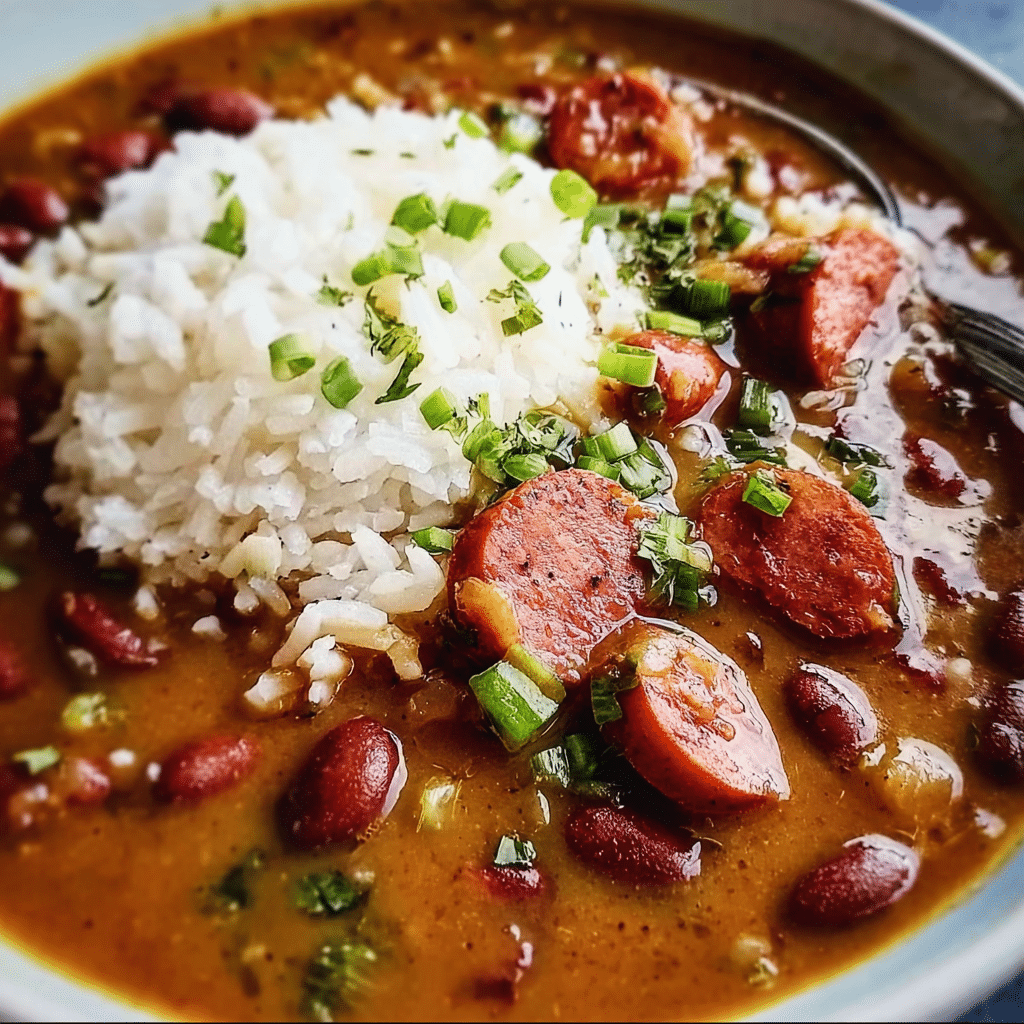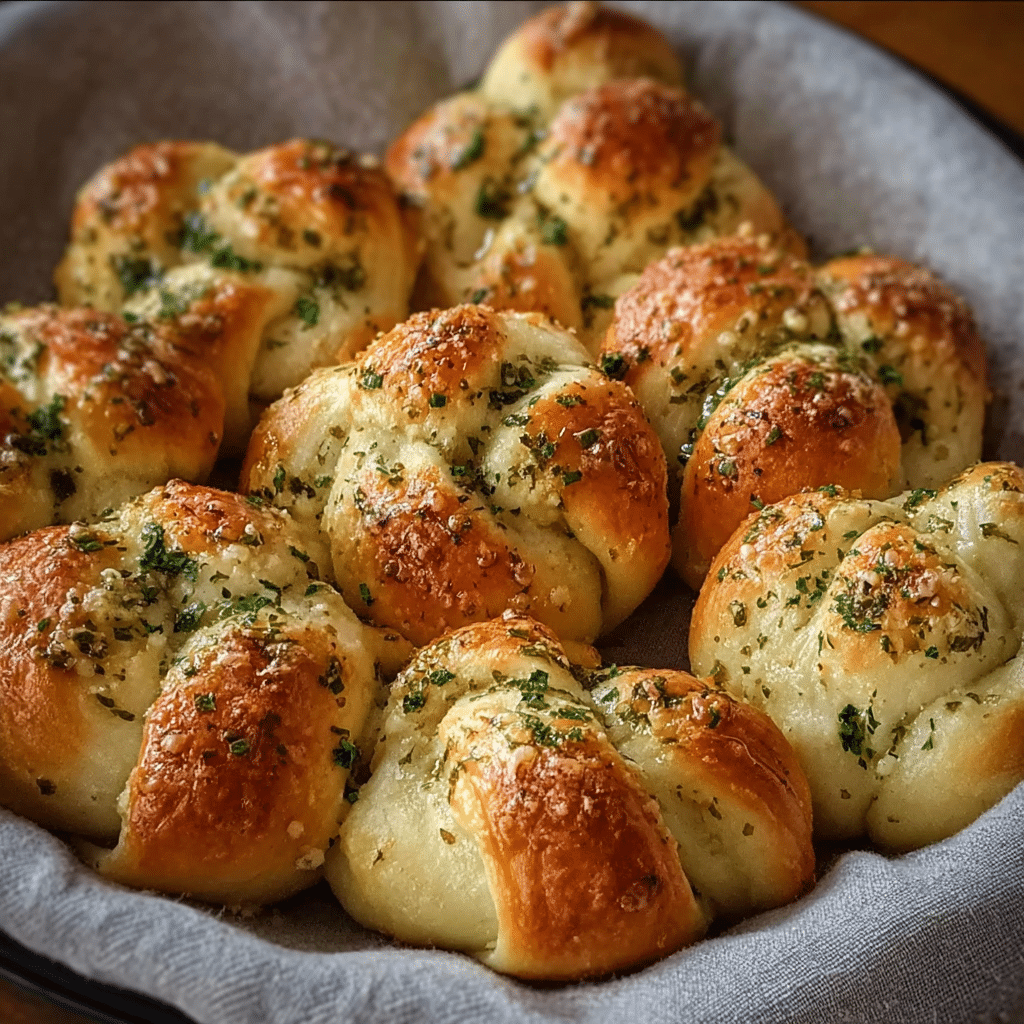Beef pepper soup is not just a meal; it’s a celebration of flavors, a warm embrace on a chilly night, and a cherished tradition in many households. I still vividly remember the first time I tasted this incredible dish. It was during a family gathering at my aunt’s house, where the tantalizing aroma wafted through the air, pulling everyone toward the kitchen like moths to a flame. My aunt stood over the pot, stirring the concoction with a ladle, her face a mask of concentration, yet her eyes sparkled with joy. I was a child then, and the sight of the bubbling broth filled with chunks of tender beef and vibrant spices ignited my curiosity about cooking.

As I approached, the warmth of the kitchen enveloped me. I watched in awe as she introduced me to the ingredients—fresh pepper, ginger, and various herbs that I had never seen before. Then came the revelation: this was beef pepper soup, a dish steeped in tradition and bursting with flavor. The first spoonful I tasted was a revelation; it was spicy yet comforting, and I could feel the warmth spreading through me, almost as if it were a hug in a bowl. From that day on, I was determined to learn how to make beef pepper soup, and it has since become a staple in my own home, a dish that I love to prepare for family and friends.
The Story Behind This Recipe
This dish is more than just a recipe; it’s a window into the rich tapestry of cultural history. Beef pepper soup has its roots in West African cuisine, especially among the Yoruba and Igbo communities in Nigeria. Traditionally, it was not merely a comfort food but was also believed to have medicinal properties, often served to those who were feeling under the weather or recovering from illness. The use of fresh spices in the recipe is thought to be not only for flavor but also for their health benefits, promoting warmth and wellness.
What makes beef pepper soup stand out among other soups is its unique blend of spices and its ability to be tailored to personal preferences. Some may choose to add more pepper for heat, while others may opt for additional herbs like scent leaves or basil for a more aromatic experience. This flexibility allows families to create a dish that is uniquely theirs while still paying homage to the traditional roots. Moreover, its quick cooking time makes it an ideal solution for busy families looking for a nourishing dinner option that doesn’t require hours in the kitchen.
Why You’ll Love This Dish
Beef pepper soup is perfect for any season, but it holds a special place in the hearts of many during the cooler months. The warmth of the soup, combined with the spicy kick, serves as a remedy for the chill in the air, making it a go-to dish during gatherings or celebrations. Be it a holiday feast or a simple weeknight dinner, this soup brings people together around the table, sparking laughter and conversations.
My emotional connection to beef pepper soup runs deep. It’s a dish that evokes memories of family, laughter, and love. Every time I prepare it, I can almost hear my aunt’s laughter filling the kitchen as she recounted stories from her childhood. I can feel my grandmother’s wise teachings echoing in my ears as I add spices to the pot. It’s more than just a recipe; it’s a legacy that I am proud to pass down to my children.
In this ultimate guide to beef pepper soup, you will learn everything from the history of the dish to its cultural significance and various regional adaptations. You will discover tips on how to prepare it perfectly, variations to suit your taste, and how to serve it to impress your guests. Whether you’re a seasoned cook or a novice in the kitchen, you will find a wealth of knowledge to help you create your very own bowl of beef pepper soup, filled with warmth, flavor, and love.
The Rich History and Cultural Significance of beef pepper soup
The rich history and cultural significance of beef pepper soup is a testament to its enduring popularity in West African cuisine, particularly in Nigeria. This soup is deeply rooted in the traditions of the communities that have passed it down through generations. It is a dish that speaks to the heart of family gatherings, community celebrations, and even personal milestones, serving as a culinary marker of life’s important events.
Origins and History
Beef pepper soup has origins that can be traced back to various ethnic groups in West Africa. The Yoruba and Igbo tribes in Nigeria are particularly noted for their unique takes on this dish. Traditionally, the soup is made with a range of meats, but beef has become one of the most popular choices due to its availability and rich flavor. The preparation of the soup is often rooted in the cultural practices of these communities, where food is not just sustenance but a way to forge connections and celebrate heritage.
Historically, beef pepper soup was often reserved for special occasions, such as weddings or festivals, where it served as a symbol of hospitality and abundance. The spices used in this dish, primarily pepper, ginger, and various aromatic herbs, are not just for flavor; they hold cultural significance as well. For instance, the use of pepper is often associated with life and vitality in many African cultures, believed to ward off illness and promote health.
As communities evolved, so did the dish. The basic elements of beef pepper soup remained intact, but regional variations began to emerge. In some areas, you might find the addition of local herbs like scent leaves, while others might prefer to use a variety of meats, including goat or chicken. Each variation tells a story of the local culture and the ingredients that are readily available, making it a dynamic and ever-evolving dish.
Cultural Significance
Beef pepper soup holds significant cultural importance in many West African households. It is often served during important family gatherings, such as weddings, birthdays, and festivals. The act of cooking and sharing this dish is a communal experience, where friends and family come together to enjoy a meal that is both nourishing and heartwarming. It is not uncommon to see large pots of beef pepper soup simmering on outdoor fires during festivities, bringing people together for laughter and storytelling.
Additionally, the soup is often associated with healing properties. Many families prepare beef pepper soup for loved ones who are ill, believing that the spices and warmth of the soup can help restore health. This practice underscores the deep emotional connection that people have with food and the role it plays in their lives, serving as both comfort and nourishment.
Nutritional Benefits
Aside from its cultural significance, beef pepper soup offers numerous nutritional benefits. The primary ingredient, beef, is a rich source of protein, essential for muscle repair and overall health. Moreover, the spices used in the soup, such as ginger and pepper, have been known for their anti-inflammatory and antioxidant properties. Ginger, in particular, is often used in traditional medicine for its ability to ease digestive issues and enhance immune function.
Furthermore, the inclusion of fresh herbs and vegetables not only adds flavor but also boosts the nutritional profile of the dish. Ingredients like scent leaves and other local herbs provide vitamins and minerals that contribute to overall wellness. This makes beef pepper soup not just a delicious meal but also a wholesome choice for families looking to nourish their bodies.
The evolution of beef pepper soup, along with its rich history and cultural significance, has cemented its place in the hearts and kitchens of many. As you explore this dish, you will not only be engaging in a culinary adventure but also connecting with the stories and traditions that have shaped it over time. From its origins to its current variations, beef pepper soup is a dish that continues to evolve while remaining a cherished part of cultural heritage.
Essential Ingredients for Perfect beef pepper soup
When embarking on the culinary journey of making beef pepper soup, it’s essential to gather the right ingredients to create a dish that is not only flavorful but also authentically representative of its cultural roots. This delicious soup is a staple in many West African countries, particularly Nigeria, and is known for its aromatic spices and warming qualities. Below, we will explore the essential ingredients for making the perfect beef pepper soup, including their roles, quality indicators, and tips for sourcing them.
Essential Ingredients
- Beef (2 lbs): Choose well-marbled cuts like brisket or shank for a richer flavor. Look for bright red meat with a firm texture. The fat content will enhance the soup’s richness.
- Water (6 cups): Use clean, filtered water to ensure the purity of the broth. The water will absorb flavors from the spices and beef, making it a vital component.
- Onion (1 large, chopped): Onions add sweetness and depth to the soup. Opt for yellow or white onions for a balanced flavor.
- Garlic (4 cloves, minced): Garlic brings a pungent and aromatic quality. Fresh garlic is preferable for maximum flavor.
- Ginger (1 inch, grated): Fresh ginger provides a warming heat that complements the peppery flavor of the soup. It’s essential for that authentic taste.
- Fresh Pepper (Scotch bonnet or habanero, to taste): These peppers add the signature heat to the soup. Adjust the quantity based on your spice tolerance.
- Seasoning (2-3 teaspoons of salt): Salt enhances all the flavors in the soup. It’s crucial to adjust this based on your taste preferences.
- Pepper Soup Spice Mix (2 tablespoons): This blend typically includes calabash nutmeg, alligator pepper, and other spices that define the flavor of this dish. You can find pre-mixed versions or create your own.
- Fresh Herbs (optional, such as scent leaf or basil): These herbs add freshness to the soup. If you can find scent leaf (also known as African basil), it’s particularly traditional.
Each ingredient plays a pivotal role in crafting the perfect beef pepper soup. The beef is the star, providing a rich, hearty base. The spices and peppers are what elevate this dish, bringing warmth and complexity to the flavor profile. Onions, garlic, and ginger add layers of aroma and taste, making each spoonful comforting and satisfying.
Print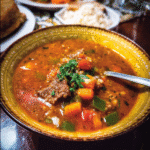
Beef Pepper Soup Recipe
Ingredients
- 1 tablespoon olive oil
- 1 pound ground beef I use 90% lean
- 3/4 cup chopped onion
- 1 1/2 teaspoons garlic minced
- salt and pepper to taste
- 1 red bell pepper cut into 1/2 inch pieces
- 1 green bell pepper cut into 1/2 inch pieces
- 1 14.5 ounce can petite diced tomatoes
- 1 15 ounce can tomato sauce
- 1 14.5 ounce can beef broth
- 2 teaspoons Italian seasoning
- 2 cups cooked white rice
- 2 tablespoons chopped parsley
Instructions
- Heat the olive oil in a large pot over medium high heat. Add the ground beef and cook until browned, breaking up into smaller pieces with a spatula (approximately 5-6 minutes).
- Add the onion to the pot and cook for 4-5 minutes or until softened. Add the garlic and cook for 30 seconds.
- Season the beef and onion mixture with salt and pepper.
- Add the bell peppers to the pot and cook for 2-3 minutes.
- Add the tomatoes, tomato sauce, beef broth and Italian seasoning to the pot; bring to a simmer.
- Cook for 15-20 minutes or until peppers are tender.
- Stir in the rice and season the soup with salt and pepper to taste as desired. Sprinkle with parsley and serve.
Shopping Tips
When shopping for ingredients, quality is paramount. Here are some tips for selecting the best components for your beef pepper soup:
- Beef: Look for cuts that are bright red and have a good amount of marbling. If possible, visit a local butcher who can offer fresh, high-quality meat.
- Spices: Freshness matters! Check the expiration dates and smell the spices to ensure they are aromatic. If you can, buy whole spices and grind them at home for the best flavor.
- Fresh Produce: Choose firm, unblemished onions and peppers. If buying fresh herbs, look for vibrant leaves without any wilting or browning.
Additionally, consider seasonal availability. For instance, peppers tend to be more flavorful and vibrant in warmer months. Visiting local farmers’ markets can also yield fresh, organic produce that enhances the quality of your dish.
Substitutions and Alternatives
While traditional ingredients are key for authenticity, there are substitutions you can make if certain items are unavailable or if dietary restrictions exist:
- Beef: For a lighter version, you can use chicken or even tofu for a vegetarian option. Adjust cooking times accordingly.
- Peppers: If Scotch bonnet peppers are too spicy, try using bell peppers for a milder flavor, though it will lack the characteristic heat.
- Herbs: If scent leaf is not available, fresh basil or cilantro can provide a pleasant alternative.
When it comes to storage, keep your spices in a cool, dark place to maintain their potency. Fresh vegetables should be stored in the refrigerator and used within a week for optimal freshness. Meat should be kept in the coldest part of your fridge or frozen if you’re not cooking it right away.
Finally, to save costs, consider buying in bulk, especially spices, as they tend to be cheaper this way. You can also look for sales on meat and freeze portions for future meals. Organic versus conventional is a personal choice, but when it comes to spices and fresh produce, organic options often provide a more robust flavor.
Armed with this knowledge of ingredients, you are one step closer to mastering the art of beef pepper soup, a dish rich in flavor and cultural significance.
Detailed Step-by-Step beef pepper soup Cooking Instructions
Creating a delightful bowl of beef pepper soup is not just a cooking task; it’s an experience filled with aromatic scents, vibrant colors, and the warmth of home. With the right ingredients at hand, let’s delve into the step-by-step process of making this comforting dish that carries the essence of West African cuisine. The entire cooking process takes about 30 minutes, making it an accessible dish for any home cook.
Preparation Steps
Before diving into the cooking process, preparation is key to ensuring everything goes smoothly. This is often referred to as mise en place, a French term meaning “everything in its place.” Here’s how to prepare:
- Chop the Vegetables: Begin by chopping the onion into small pieces, mincing the garlic, and grating the ginger. Set these aside in a bowl for easy access during cooking.
- Prepare the Beef: Cut the beef into bite-sized cubes, ensuring even sizes for consistent cooking. Pat the beef dry with a paper towel to enhance browning.
- Measure Your Spices: Pre-measure the salt, pepper soup spice mix, and any other spices you plan to use. Having these ready will streamline your cooking process.
- Prep the Peppers: If using fresh peppers, remove the seeds and chop them finely. Be cautious when handling hot peppers; wearing gloves can prevent irritation.
- Gather Cooking Tools: Have a large pot or Dutch oven ready, along with a wooden spoon and a ladle for serving.
With everything prepped, it’s time to start cooking!
Cooking Process
The cooking process for beef pepper soup is both straightforward and rewarding. Follow these steps for a delicious result:
- Brown the Beef: Heat a tablespoon of oil in your pot over medium heat. Once hot, add the beef cubes and brown on all sides, which should take about 5-7 minutes. This step is crucial as it adds depth of flavor to your soup.
- Add Onions, Garlic, and Ginger: Once the beef is browned, add the chopped onions, minced garlic, and grated ginger to the pot. Sauté these for about 3-4 minutes until the onions become translucent and aromatic.
- Add Water: Pour in the 6 cups of water, scraping the bottom of the pot to release any flavorful bits stuck to the bottom. This will build the base of your broth.
- Incorporate Spices: Stir in the salt and the pepper soup spice mix. This is where the magic happens, as the spices infuse the broth with their rich flavors.
- Bring to a Boil: Increase the heat to bring the soup to a rolling boil. Once boiling, reduce the heat to a simmer.
- Add Peppers: Add the chopped peppers at this stage. If you prefer a milder soup, you can hold some peppers back and add them towards the end of cooking to preserve some of their freshness.
- Simmer: Allow the soup to simmer for about 15-20 minutes or until the beef is tender. Check the consistency and flavor, adjusting salt or spices as needed.
- Finish with Fresh Herbs: Just before serving, stir in any fresh herbs you’ve chosen, such as scent leaf or basil, giving the soup a fresh lift.
Throughout the cooking process, pay attention to the aromas filling your kitchen. The scent of ginger, garlic, and spices mingling with the beef will have your mouth watering in anticipation. A key visual cue is when the beef is fork-tender, indicating that it has absorbed all the flavorful broth.
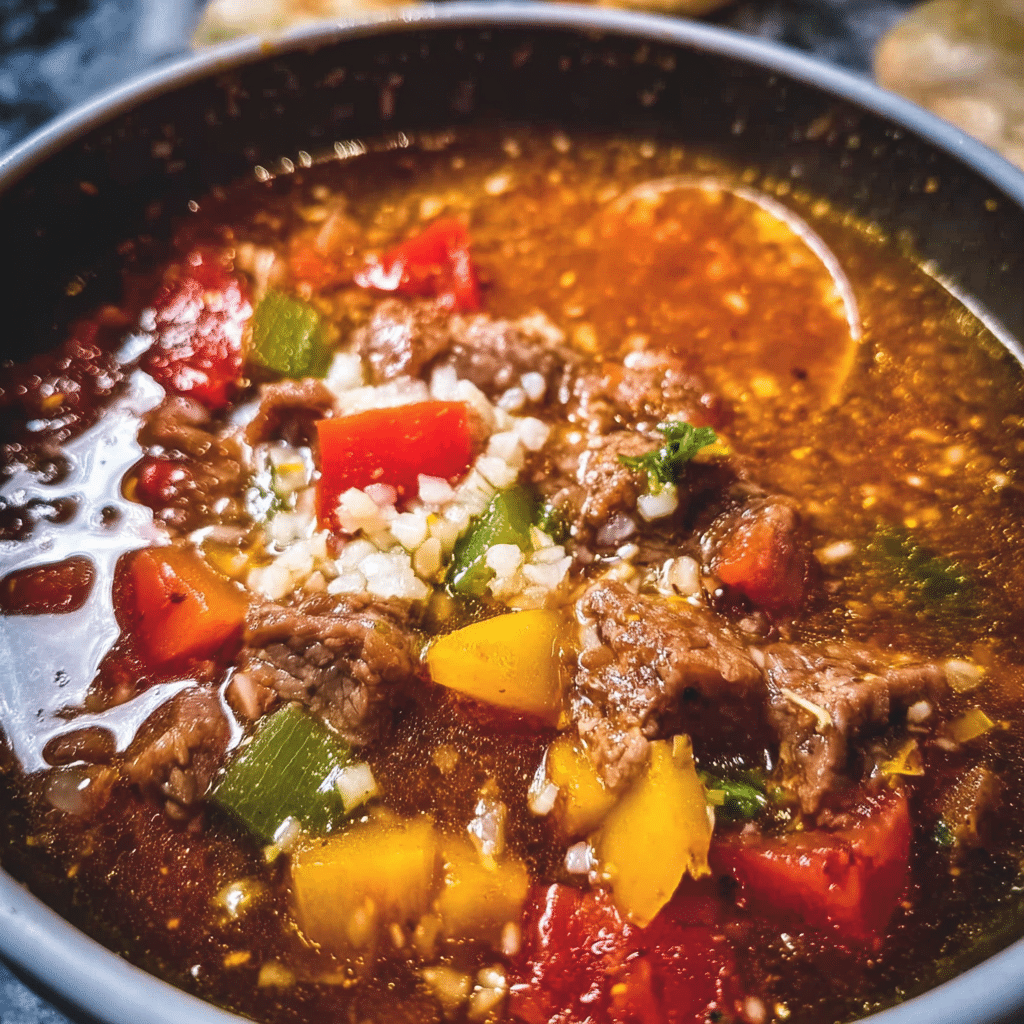
Final Assembly
Once the cooking time is complete, it’s time for the final assembly:
- Check for Seasoning: Taste the soup and adjust seasoning if necessary. A touch more salt or a squeeze of lime can elevate the flavors.
- Serve Hot: Ladle the soup into bowls, ensuring each serving has a good amount of beef and broth. The vibrant colors of the peppers and herbs should be visible.
- Garnish: If desired, garnish with additional fresh herbs or thinly sliced peppers for a pop of color.
Common mistakes to avoid include not browning the beef properly, which can lead to a lack of depth in flavor, or overcrowding the pot, which can inhibit cooking. Remember, patience is key. Allow the flavors to meld and develop throughout the simmering process.
Equipment-wise, a heavy-bottomed pot is ideal for even heat distribution. If you don’t have one, a slow cooker can be used for a more hands-off approach, though cooking times will vary.
Finally, practice food safety by ensuring the beef reaches an internal temperature of at least 145°F (63°C) for safe consumption. With these instructions, you’ll create a comforting bowl of beef pepper soup that is sure to warm hearts and bellies alike.
Professional Tips and Techniques for beef pepper soup
Beef pepper soup is one of those warm, comforting dishes that not only tantalizes your taste buds but also brings a sense of nostalgia. Growing up, I remember my grandmother preparing her special version of beef pepper soup on rainy days, filling the house with a spicy, fragrant aroma that hinted at the deliciousness to come. To recreate that magic in your kitchen, I’ve compiled some professional tips and techniques that will elevate your beef pepper soup to the next level.
Professional Techniques
To start, the choice of beef is crucial. For the most flavorful beef pepper soup, opt for cuts that are rich in flavor like brisket, shank, or even oxtail. These cuts have a good amount of connective tissue that breaks down beautifully during cooking, resulting in a rich broth. If you’re feeling adventurous, try using bone-in pieces for added depth. A slow simmer will coax out the flavors, so don’t rush the cooking process. Aim for at least an hour of simmering on low heat.
Next, let’s talk spices. The right blend of spices is the heart of any great beef pepper soup. A classic mix includes black pepper, chili pepper, and a hint of ginger. However, don’t shy away from experimenting with other spices like allspice or cloves for added complexity. Toasting your spices lightly in a dry pan before adding them to your soup will intensify their flavors. Remember to start with a small amount and adjust to your taste; you can always add more, but it’s tough to fix an overly spicy soup!
When it comes to the cooking method, don’t hesitate to utilize a pressure cooker if you’re short on time. It can significantly reduce the cooking time while still achieving that tender beef texture. If you prefer a more traditional approach, a stovetop method works wonderfully—just allow ample time for the flavors to meld.
Troubleshooting Guide
As with any dish, you may encounter some common problems when making beef pepper soup. If your soup tastes bland, consider adjusting the seasoning. Sometimes, a little salt or a splash of vinegar can brighten up the flavors. If you find your soup too spicy, add a dollop of sour cream or coconut milk to mellow the heat.
If your broth is cloudy, this can often be resolved by skimming off any foam that rises to the surface during the initial simmering stage. This foam consists of impurities that can cloud your delightful broth. Always remember to strain your soup before serving for a cleaner presentation.
Presentation Tips
Speaking of presentation, the way you serve your beef pepper soup can make a significant impact. Consider garnishing with fresh herbs like cilantro or parsley for a pop of color. A sprinkle of chopped green onions or a slice of lime on the side adds a refreshing touch that enhances both the visual appeal and flavor profile.
When plating, use deep bowls that allow the rich broth to shine through. You might also serve it with a side of crusty bread or fluffy rice to soak up that delicious broth. A well-set table with your favorite beverage can turn a simple meal into a delightful experience. Speaking of beverages, a chilled white wine or a light lager pairs beautifully with the spiciness of beef pepper soup.
Make-Ahead and Meal Prep Strategies
Beef pepper soup can be a fantastic make-ahead meal. The flavors deepen and become even better the next day. Simply prepare your soup, let it cool, and store it in an airtight container in the refrigerator for up to three days. You can also freeze it for longer storage—just ensure you leave some space in the container as the soup will expand when frozen.
Scaling your recipe up or down is also quite simple. If you’re feeding a crowd, doubling the recipe is straightforward. Just remember to adjust your cooking time accordingly, as a larger batch may require a little more time to reach that tender perfection. On the flip side, if you’re cooking for one or two, you can easily halve the recipe without any issues.
In conclusion, making beef pepper soup is both an art and a science. With the right techniques, troubleshooting knowledge, and presentation skills, you can serve a bowl of this delightful dish that not only warms the belly but also creates memories that last a lifetime. So roll up your sleeves, gather your ingredients, and get ready to make a pot of beef pepper soup that would make any food enthusiast proud!
Creative Variations and Adaptations of beef pepper soup
Beef pepper soup is a classic dish, but one of the most exciting aspects of cooking is making a recipe your own. Just as each family has its secret twists on traditional recipes, there are countless ways to adapt beef pepper soup to suit the seasons, dietary preferences, and even culinary trends. Let’s dive into some creative variations and adaptations that can breathe new life into this beloved dish.
Seasonal Variations
Seasonal ingredients can transform your beef pepper soup into something extraordinary. In the fall, consider adding root vegetables like carrots, parsnips, or sweet potatoes. Not only do they add sweetness and texture, but they also make the soup heartier. During the summer months, fresh vegetables like zucchini, corn, or bell peppers can lighten the dish while contributing vibrant colors and flavors.
Moreover, herbs can play a significant role in seasonal variations. In the spring, fresh basil or mint can add a refreshing twist to your beef pepper soup. In contrast, during the winter months, using dried herbs like thyme or rosemary can provide a comforting warmth. These slight modifications not only adjust the taste but also reflect the bounty of each season.
Dietary Adaptations
In today’s world, many are seeking dietary modifications, and beef pepper soup is surprisingly versatile when it comes to accommodating different diets. If you’re looking to make a keto-friendly version, simply replace the starchy vegetables with leafy greens such as spinach or kale. You can also make it gluten-free by ensuring your broth is free from any gluten-containing ingredients.
For those following a vegan or vegetarian lifestyle, you can substitute the beef with hearty plant-based proteins like mushrooms or jackfruit, which provide a meaty texture. A vegetable broth infused with spices can recreate the depth of flavor you would typically find in beef pepper soup. Don’t forget to adjust the spices accordingly, as plant-based dishes sometimes require a bit more seasoning to achieve that satisfying taste.
Creative Twists
If you’re feeling adventurous, consider trying some international fusion variations of beef pepper soup. Think about incorporating flavors from different cuisines. For a Thai-inspired twist, add coconut milk and lemongrass, and serve it with a squeeze of lime for a refreshing finish. Alternatively, you could craft a Mexican-style beef pepper soup by adding chipotle peppers and serving it with avocado and tortilla strips.
Another fun way to reinvent this classic is by experimenting with different cooking methods. While the traditional stovetop technique is tried and true, utilizing a slow cooker allows for the flavors to meld beautifully over several hours, making it a perfect option for meal prep. On the other hand, if you’re short on time, a pressure cooker can produce a flavorful soup in a fraction of the time, ensuring you don’t miss out on this delicious dish during a busy week.
Let’s not forget about leftovers! If you find yourself with extra beef pepper soup, consider transforming it into a new meal altogether. Use the soup as a base for a spicy stew, or pour it over a bed of rice or quinoa for a satisfying grain bowl. You can also blend the soup into a creamy consistency and serve it as a sauce over pasta or roasted veggies for a completely different culinary experience.
In conclusion, the beauty of beef pepper soup lies in its adaptability. By incorporating seasonal ingredients, accommodating dietary preferences, and embracing creative twists, you can keep this dish exciting and fresh. So don’t hesitate to experiment and make it your own; after all, cooking is all about creativity, exploration, and enjoyment!
Storage, Reheating, and Meal Prep for beef pepper soup
When it comes to beef pepper soup, proper storage is the key to ensuring that the flavors meld beautifully while keeping the dish safe to eat. This spicy, aromatic soup is a staple in many West African households, often enjoyed during special occasions, family gatherings, or simply on a chilly evening. Let’s dive into how you can store, reheat, and meal prep your beef pepper soup to keep it delicious and safe.
Short-term Storage
For short-term storage, you’ll want to keep your beef pepper soup in the refrigerator if you plan to consume it within a few days. After cooking, allow the soup to cool to room temperature before storing it in an airtight container. This is crucial as it prevents condensation from forming, which can lead to unwanted moisture and spoilage. I often use glass containers with tight-fitting lids, as they are non-reactive and can withstand temperature changes without warping.
In the refrigerator, beef pepper soup can last for about 3 to 4 days. To maintain freshness, it’s best to store the soup without garnishes like fresh herbs or sliced vegetables, as these can wilt or lose their texture quickly. When storing, you might consider portioning the soup into smaller containers; this not only makes reheating easier but also helps in controlling serving sizes, especially if you’re watching your intake. I usually fill my containers with just enough for one meal, making it convenient to grab and go during busy weekdays.
Freezing and Long-term Storage
If you want to extend the shelf life of your beef pepper soup, freezing is the way to go. Properly frozen, your soup can last for up to 3 months without losing its flavor or texture. To freeze, first, let the soup cool completely. Then, transfer it to freezer-safe containers or heavy-duty freezer bags. I prefer using bags because they take up less space in the freezer and are easier to stack.
When using freezer bags, make sure to remove as much air as possible before sealing. This helps prevent freezer burn, which can compromise the quality of your beef pepper soup. Label your bags with the date and contents to keep track of your frozen meals. If you have a vacuum sealer, that’s even better, as it’ll keep your soup fresh for a longer period.
When you’re ready to enjoy your frozen beef pepper soup, thaw it in the refrigerator overnight or use the defrost setting on your microwave if you’re short on time. Once thawed, you can reheat it on the stove over medium heat, stirring occasionally until heated through. If the soup appears a bit thick after thawing, simply add a splash of water or broth to restore its original consistency.

Reheating Best Practices
Reheating beef pepper soup should be done carefully to keep its flavors intact. The best method is to reheat it on the stovetop in a pot. Pour the soup into a saucepan and heat over medium-low heat, stirring frequently. This method allows for even heating and reduces the risk of burning the bottom. If you’re in a hurry, you can use the microwave, but I recommend doing so in short intervals. Heat for about 1-2 minutes, stirring in between, until the soup is hot throughout.
One of my favorite tips is to add a few fresh herbs or a squeeze of lime just before serving. This brightens up the flavors and gives the soup a freshly made taste, even if it’s been sitting in the fridge or freezer for a while.
Food safety is paramount when it comes to storing and reheating beef pepper soup. Always ensure that soup is heated to at least 165°F (74°C) before consuming. If the soup has been sitting out at room temperature for more than two hours, it’s best to discard it to prevent foodborne illnesses. Remember, the quality of your ingredients plays a crucial role in how well the soup stores and reheats.
In conclusion, with proper storage methods, you can enjoy your beef pepper soup days or even weeks after it was initially prepared. The key is to cool it down efficiently, store it wisely, and reheat it correctly to maintain the dish’s signature flavors and aromas.
Nutritional Benefits and Health Information
Beef pepper soup is more than just a comforting dish; it’s packed with nutrients and offers various health benefits. It’s a fantastic way to incorporate protein, vitamins, and minerals into your diet while enjoying a delicious meal. Let’s explore the nutritional aspects of beef pepper soup and how it can fit into various dietary plans.
Nutritional Profile
At the core of beef pepper soup is, of course, the beef. Depending on the cut, a serving of beef pepper soup can be rich in protein, providing about 25-30 grams per serving, making it an excellent source of this essential macronutrient. Protein is crucial for muscle repair and growth, making beef pepper soup a great post-workout meal.
Alongside the beef, the soup typically includes a variety of spices and vegetables that contribute additional nutrients. For instance, onions and peppers are often used, both of which provide vitamins A and C, crucial for immune function and skin health. The spices, such as ginger, garlic, and pepper, not only enhance the flavor but also offer anti-inflammatory properties.
A standard serving of beef pepper soup can contain approximately 300-400 calories, depending on the amount of oil used and the specific ingredients added. The macronutrient distribution is generally balanced, with protein from the beef, carbohydrates from any added vegetables, and fats from the cooking oil.
Health Benefits
Beef pepper soup is not just delicious; it’s also loaded with health benefits. The ingredients used in the soup, especially the spices, have been known to possess various health-promoting properties. For example, peppers contain capsaicin, which has been shown to boost metabolism and may assist in weight management. Similarly, ginger is known for its digestive benefits and can help alleviate nausea.
The broth itself can be very hydrating, especially if consumed warm, and is often recommended for those under the weather. Many cultures believe that spicy foods can help clear sinuses and stave off colds, making beef pepper soup a popular choice during flu season.
Dietary Considerations
When it comes to dietary considerations, beef pepper soup is quite versatile. Those following a ketogenic or low-carb diet will appreciate its high protein and fat content, especially if made with fatty cuts of beef. However, for those who are watching their fat intake, using leaner cuts of beef or reducing the amount of oil used in preparation can make the soup lighter without sacrificing flavor.
For individuals with specific dietary restrictions, such as gluten intolerance or dairy allergies, beef pepper soup can be easily modified. This dish is naturally gluten-free and can be made without any dairy products. Just be mindful of any store-bought seasonings or bouillons that may contain gluten or additives.
For a heart-healthy version, consider using leaner cuts of beef or even substituting with chicken or turkey. These alternatives can lower the saturated fat content while still providing a hearty and satisfying meal.
When comparing beef pepper soup to similar dishes, it stands out due to its unique blend of spices and flavors. While other soups may be creamy or tomato-based, beef pepper soup is broth-based, making it lighter yet still deeply flavorful. This makes it a great option for those looking for comfort food without the heaviness often associated with creamy soups.
In conclusion, beef pepper soup is not only a delightful dish that warms the soul but also a nutritionally rich meal that can be adapted to fit various diets. With its high protein content, beneficial spices, and versatility, it’s a fantastic addition to anyone’s culinary repertoire. Whether you enjoy it on a chilly night or as a part of a larger feast, beef pepper soup is sure to satisfy and nourish.
Frequently Asked Questions About Beef Pepper Soup
Beef pepper soup slow cooker
To prepare beef pepper soup in a slow cooker, start by browning your beef in a skillet to enhance its flavor, which adds depth to the final dish. Next, transfer the browned beef to the slow cooker along with chopped onions, garlic, and your choice of spices—typically, a blend of peppercorns, ginger, and thyme works wonderfully. Pour in enough broth or water to cover the meat and vegetables, and let it cook on low for 6-8 hours or high for 4-5 hours. For an extra kick, add sliced scotch bonnet peppers or other hot peppers towards the end of the cooking time. Remember to adjust seasonings and serve hot with a side of rice or bread to soak up the flavorful broth.
Amish stuffed pepper soup
Amish stuffed pepper soup combines the hearty flavors of stuffed peppers with the ease of a soup. To make this dish, start by browning ground beef with onions and garlic in a large pot. Once cooked, stir in diced bell peppers, canned tomatoes, rice, and broth, then season with salt, pepper, and Italian herbs for that quintessential flavor profile. Allow the soup to simmer until the rice is tender, about 20-30 minutes. For a touch of sweetness, consider adding a splash of Worcestershire sauce or a pinch of sugar, and always taste for seasoning before serving!
Stuffed pepper Soup Pioneer Woman
The Pioneer Woman’s stuffed pepper soup is a comforting twist on classic stuffed peppers, packed with flavor and texture. Start by sautéing diced onions, bell peppers, and ground beef in a large pot until the meat is browned and the vegetables are tender. Next, add diced tomatoes, broth, and cooked rice or quinoa for added substance to the soup. Season with paprika, garlic powder, and oregano to elevate the taste. Allow it to simmer for at least 20 minutes to let the flavors meld, and serve with a sprinkle of cheese on top for an extra indulgent touch!
Taste of Home stuffed pepper soup
Taste of Home’s stuffed pepper soup is a family-friendly meal that captures the essence of traditional stuffed peppers. Begin by browning ground beef along with chopped onions and garlic, then add in diced bell peppers and cook until they soften. Stir in a combination of beef broth, diced tomatoes, and tomato sauce to create a rich base, and mix in cooked rice for added texture. Season generously with salt, pepper, and Italian herbs (like basil and oregano) to enhance the soup’s flavor. For a finishing touch, garnish each bowl with fresh parsley or grated cheese for added flavor and presentation!

